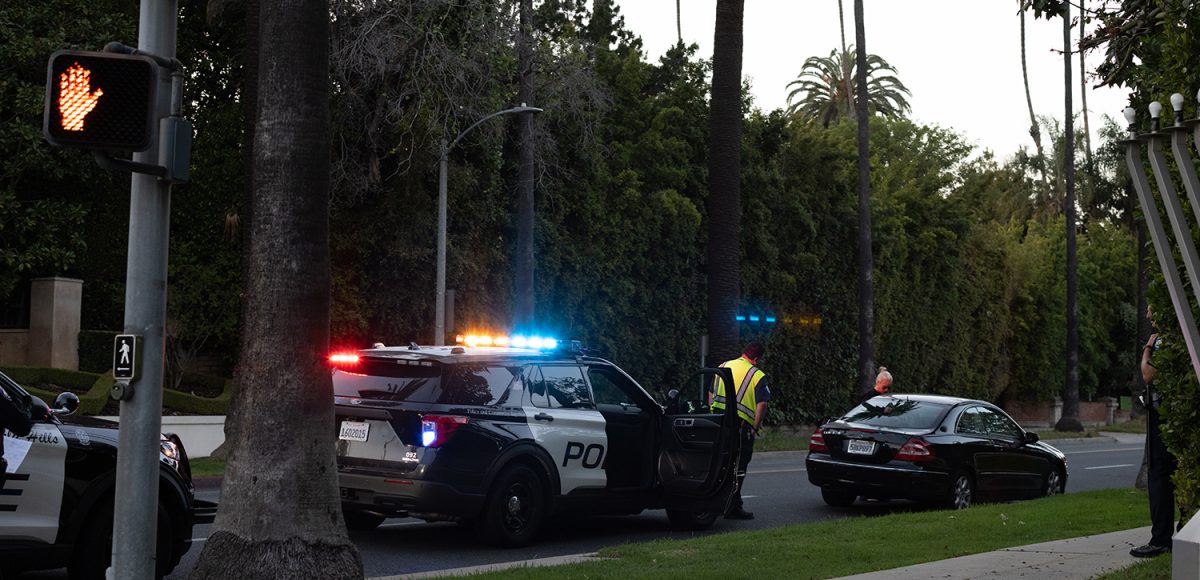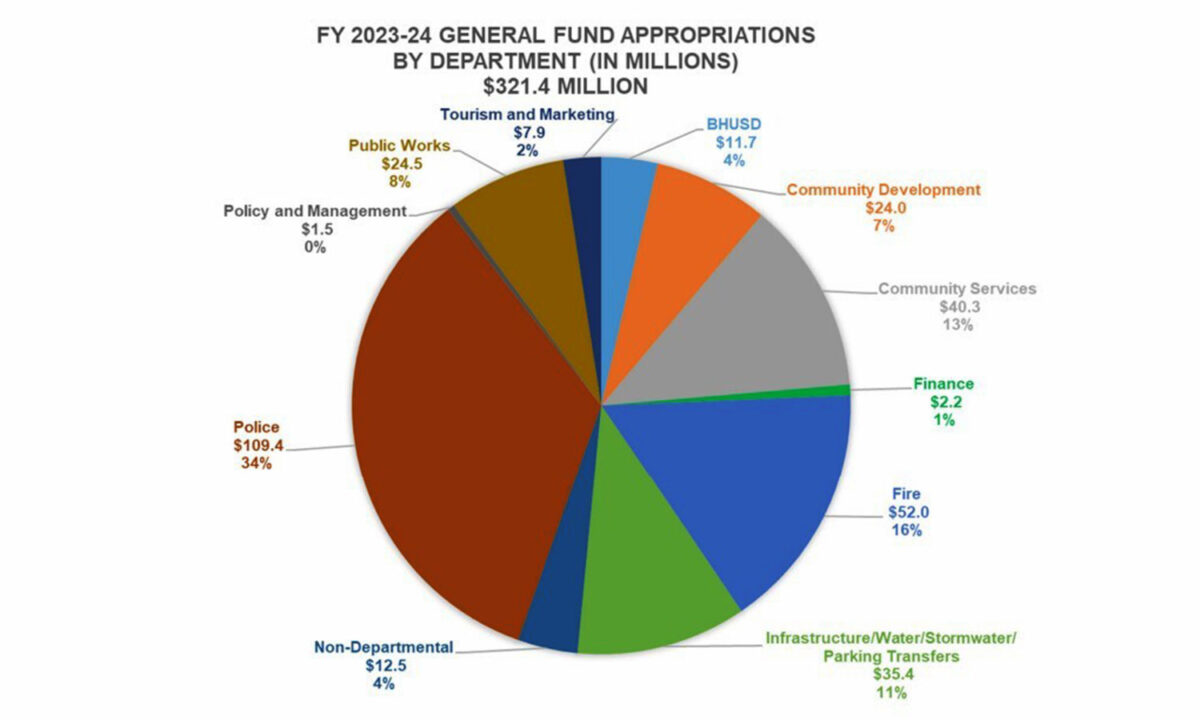The Beverly Hills City Council approved nearly half a million dollars to establish the Real Time Watch Center, a new hub to coordinate the city’s many surveillance tools.
The initiative has been months in the making, said Beverly Hills Police Department (BHPD) Chief Mark Stainbrook, who described the center as “the way of the future for policing.”
“Although we have a lot of good technology, and we’ve started introducing new technology, like drones and more automated license plate readers, the real question is how do we use this technology together in the most effective and integrated manner,” Stainbrook told the Council on April 13.
The city hopes the center will reduce the amount of time it takes officers to respond to calls, facilitate early intervention in criminal activity, and improve evidence and information gathering. Stainbrook said the department’s goal was to “reduce crime itself and the fear of crime.”
The city currently employs “three big technologies,” Stainbrook said, including Closed Circuit Television (CCTV) cameras, automated license plate readers (ALPRs), and drones. The Watch Center will centralize these technologies along with new initiatives like BHPD Alert, Live911, and a new intelligence unit.
The city launched its CCTV camera program more than 15 years ago with the aim of achieving “ubiquitous coverage” throughout the city. The city currently has more than 2,000 cameras, prompting Chief Information Officer David Schirmer to say in 2020 that the city was “leading the pack” in cameras per capita globally.
“Currently, the way we operate is when a crime happens, we go back and we review the video footage from where the crime happened, try to identify vehicles and suspects and put our case together and make arrests,” Stainbrook said. “But what we want to get to in the future is live monitoring of the cameras.”
According to the plan laid out by Stainbrook, the watch center will tap the city’s existing private security contractors, Covered 6 and Nastec International, to monitor the cameras. The $500,000 allotment budgets for two pairs of operators working two eight-hour shifts each day. Stainbrook said he expects to “go live” with the camera monitoring by the first full week of June.
The second technological pillar, ALPRs, will help the city intercept people driving stolen cars or suspects with active warrants and prevent them from committing possible future crimes, according to Stainbrook.
“To get ahead of that, the more license plate readers we have that can tell us that a stolen car is entering the city or a car that’s already on a wanted list, the quicker we can respond and react to that vehicle in the city,” he said.
The department plans on adding the new ALPRs by the end of May, according to Stainbrook.
Lastly, the watch center would coordinate the city’s new drone program.
Currently, the department flies its drones four days a week for up to 10 hours a day. Stainbrook said that BHPD is training a dozen officers in the drones with the goal of moving up to 10 hours a day, seven days a week – a goal he hopes to reach by July.
The department hopes to use “drones as a first responder,” he said.
“When the drone as a first responder is not flying, our goal is to have officers that are trained to fly drones have them in their vehicles and be able to launch them at scenes when they need them,” said Stainbrook.
In response to privacy concerns raised by the Council over the drone program, Stainbrook said that the drones’ field of view could include backyards, for instance, but that drone operators “don’t focus in on backyards or anything unless there’s a call for service or there’s a reason to.”
The Real Time Watch Center would work in conjunction with the department’s other new initiative, BHPD Alert.
“When the Real Time Watch Center has information, we can push it back out to the community,” Stainbrook said.
Stainbrook elaborated on another new law enforcement initiative announced earlier by Mayor Lili Bosse, Live911, which would send emergency calls directly to nearby officers in the field. This would decrease response times by 30 seconds to two minutes, Stainbook estimated–a sizable chunk considering the department’s already fast response rate, Councilmember Dr. Julian Gold pointed out.
The program will not replace the current dispatch system. Stainbrook explained that officers would have the option whether or not to use it depending on their status.
“It’s a tool that that they can use when they need it and how they need it to be used,” Stainbrook said.
While Stainbrook did not provide a concrete timeline for launching Live911, he said that AT&T must first “provide connectivity and modem support.” After that, he said it would take four weeks to integrate the software.
The Watch Center will make use of a new intelligence unit, which will utilize a new crime analyst the department intends on hiring. The unit will use a “predictive, intelligence-driven model” for more proactive police work, according to the report.
“How we’re using our technology is really going to revolutionize the way we secure the city.
As Councilmember Robert Wunderlich pointed out, “two people couldn’t possibly monitor our 2000 cameras.” To that end, he suggested the city look into using artificial intelligence, which “would have the ability to monitor all of our cameras.”
The city currently uses an artificial intelligence program called BriefCam, which enables faster video review, facial recognition, multi-camera search, among other features. But the staff report acknowledges that BriefCam “may not be the best system for real time management, communication, and coordination for our combined technological resources.”
Councilmember John Mirisch touched on concerns about bias in artificial intelligence and facial recognition. Multiple studies over the last few years have made claims of racial and gender bias in facial recognition technology.
Nonetheless, Mirisch voiced support for the tools.
“Obviously, I’m in favor of using AI. I’m also in favor of using facial recognition, as long as it is unbiased,” he said.
Mirisch said he didn’t understand why the technology could be construed as a violation of somebody’s rights, describing it as a modern version of the most wanted lists found in post offices.
The American Civil Liberties Union has stood up as an opponent to facial recognition, saying the technology “presents an unprecedented threat to our privacy and civil liberties.”
“It gives governments, companies, and individuals the power to spy on us wherever we go – tracking our faces at protests, political rallies, places of worship, and more,” the organization has said.
Mirisch added that, in addition to catching criminals, the city should look at programs aimed at preventing recidivism and addressing the root causes of criminality.
Stainbrook anticipated that artificial intelligence companies will “want to test their technology” at the Watch Center because of the unique level of surveillance technology.
“My guess is we’ll have plenty of opportunity to try different AI systems and see how they improve our technology,” he said.
Drones cannot use facial recognition in California, per a state law that prohibits its use in cameras held by officers until 2023.
The department will locate the Watch Center in the Emergency Operations Center (EOC), the current base of operations for coordinating responses to large-scale events.
While the initial price tag comes out to nearly $500,000, the department estimates additional costs of roughly $2.5 million the following fiscal year, with annual recurring costs of about $1.9 million.
“It’s a lot of money,” said Gold. “I do think that for the community, we just need to basically say, we’re putting our money where our mouths are in terms of the security of the city.”
Bosse, who said she has been meeting with Stainbrook for the last few months to discuss the initiatives, praised the department for its speed in implementing the changes.
“This is April, and that within two months, everything that we’re talking about will be up and running,” she said. “That’s really extraordinary.”







